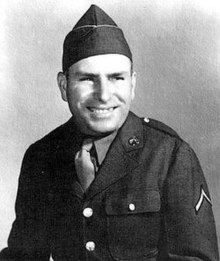Charley Havlat
Charley Havlat , born as Charles Havlat (born November 10, 1910 , Dorchester , Nebraska ; † May 7, 1945 near Volary , Czech Republic , then Prachatitz district , Bavaria ) was an American citizen of Czech descent. He is believed to be the last American soldier to be killed in action in Europe during World War II .
Life
Charley Havlat was born in Nebraska on November 10, 1910. His father, Antonín M. Havlát (1880-1958), who came from Ronov in the Czech Republic , immigrated to the United States in 1903 as part of an extended family of ten and settled as a farmer in Nebraska. There he married Antonia, geb. Nemec (1889–1956), with whom he had three sons and two daughters. Charley was the couple's oldest child.
Havlat, a truck driver by trade, joined the US Army in the early 1940s and was sent to Europe in 1943. As a member of the 803rd Tank Destroyer Battalion ( English 803rd Tank Destroyer Batallion ) he took part in some of the bloodiest battles on European soil with the rank of Private First Class (PFC), including the landing of US troops in Normandy on March 6 June 1944, the battles in the Hürtgenwald from September 1944 to February 1945 and the Ardennes offensive from December 1944 to January 1945.
On May 7, 1945, Havlat was a member of a reconnaissance platoon in South Bohemia , which was supposed to check that day whether there were enemy German troops scattered in the area of the road from Volary to Prachatitz near the village of Zbytiny. Six jeeps armed with two machine guns and escorted by an M8 reconnaissance vehicle set off. At around 8:20 a.m., the US soldiers were ambushed by German soldiers who had hidden in the surrounding forests with rifles, machine guns and bazookas . Havlat, who was in the convoy's first jeep, was killed instantly when a bullet pierced his helmet. A bazooka shot broke through the armored car and injured two other American soldiers. The others returned fire until their radio operator received the news that a ceasefire had come into effect a few minutes earlier. It turned out that the German officer hadn't known about it either; he later apologized for it. A few hours after the incident, World War II was officially over.
Charles Havlat was first buried in Volary. His younger brothers Rudolph (1912–2002) and Adolph (* 1925), who were both also stationed as soldiers in Europe at the time, visited his temporary grave there in June 1945. Havlat found his final resting place in the large military cemetery of the US Army Cimetière militaire américain de Saint-Avold in Saint-Avold in northern France (Division C, Series 5, grave 75).
Unclear place of death
There are contradicting statements about the exact place of death Havlat. The German witness Willibald Plach said that the event took place near the Säumerbrücke ( Soumarský most in Czech ). However, there are doubts as to the correctness of this statement, as this road leads west from Volary, but Havlat's group took part in an exploration of the road to Prachatice , which leads northeast. The director of the Prachatice City Museum , Pavel Fencl, believes that the shooting took place on road 141 towards Prachatice. The German witness Herbert Lang identified “An der Wasserscheide” as the collision point at which road 141 approaches the railway line from Volary to Prachatice. It matches the description of the American soldier Bernard Robinson in May 1945. Another possible location is a junction at the Mlynářovice / Cudrovice intersection in the direction of Cudrovice.
Commemorations and posthumous honors
- Charley Havlat's grave in the US military cemetery in Saint-Avold is preserved for good. It is marked with the usual white marble cross; engraved on it are his name, home state of Nebraska, rank, battalion, and date of death.
- On May 4, 2002, a monument to Charles Havlat was unveiled on the 39 road from Volary to Lenora . It consists of a high stone block with a labeled plaque. Funeral wreaths are laid there as part of the annual commemorations in Volary .
- A large plaque , a Nebraska Historical Marker , with his history was placed at the Saline County Museum in Havlat's birthplace, Dorchester . His brother Adolph wrote the text for the donation-financed $ 5,000 board.
- Charley Havlat's brother, Adolph, tried to get a section of Highway 33 in his hometown of Dorchester renamed the Charles Havlat Memorial Highway. However, his initiative failed.
Web links
Individual evidence
- ^ A b The Last American Killed in Action in Europe during World War II - American Battle Monuments Commission. In: abmc.gov. May 7, 2014, accessed on May 22, 2020 .
- ↑ Memorials: Charley Havlat (1910-1945). In: de.findagrave.com. November 10, 1910, accessed on May 22, 2020 (English, with photo of the cross).
- ↑ Havlat, Charley (803rd). Retrieved May 22, 2020 (English).
- ↑ Pomnik Charles Havlat. In: vets.estranky.cz. June 7, 2006, accessed May 22, 2020 (Czech).
- ^ Nebraska Historical Marker: PFC Charley Havlat. Retrieved May 22, 2020 (English).
- ^ Dorchester Times: Journal Star Highlights Efforts On Pvt. Havlat Memorial. In: dorchestertimes.blogspot.com. January 10, 2009, accessed May 22, 2020 .
- ^ The last GI killed in action in the ETO, a Czech-American. Retrieved May 22, 2020 (English).
| personal data | |
|---|---|
| SURNAME | Havlat, Charley |
| ALTERNATIVE NAMES | Havlat, Charles (maiden name) |
| BRIEF DESCRIPTION | American soldier |
| DATE OF BIRTH | November 10, 1910 |
| PLACE OF BIRTH | Dorchester, Nebraska , United States |
| DATE OF DEATH | May 7, 1945 |
| Place of death | at Volary |

